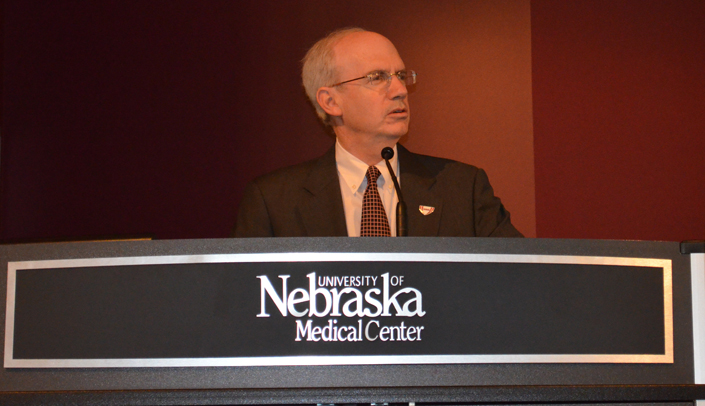Nearly 90 days on the job, UNMC’s new chancellor, Jeffrey P. Gold, M.D., presented his first state of the campus address at the annual Faculty Senate Awards Ceremony Thursday.
“I have received an incredibly warm welcome from the campus and I’m very impressed with the depth and breadth of the relationships UNMC has with the community,” he said.
“The faculty members are our heroes of campus. I’m equally impressed with the level of excellence you have achieved and I’m excited about the day-to-day opportunities we can provide to mold the next generation of health care professionals.”
Just over a year ago, Dr. Gold was summoned to the White House to participate in the Education and Training for Health Care Transformation Conference and later to the Federation of State Medical Boards as a plenary speaker where he addressed external forces, ongoing evolution and trends that impact excellence and sustainability in health care education and training.
He issued a challenge to national policy-makers in his speech, “The 10 Pillars Shaping the Future of Health Science Education,” from which he gave an abbreviated version at the faculty senate ceremony. See sidebar at right.
Looking back at history, Dr. Gold cited how the 1910 Flexner Report changed the way health care education was delivered — from apprenticeship to the academic model.
“Not all of the report is relevant today,” Dr. Gold said. “We’re coming to the end of teaching as we know it. As leadership coach Marshall Goldsmith says, ‘What got us here won’t get us there.'”
Five external forces that affect health care education have changed:
- Learner — the way students learn today, the way they effectively retain information and have access to instantaneous facts is dramatically different than that of 20 years ago.
- System — individual providers no longer deliver care as much as is now done in integrated practice groups, health care systems and across interprofessional teams.
- Educator — has a wealth of information to impart, but needs to focus on interprofessional education.
- Technology — traditional curriculum and teaching methods are rapidly being replaced, or supplemented, by advanced two-dimensional and soon three-dimensional imaging and communication technologies.
- Economics — educational costs must be managed to allow graduates to have productive careers without the burden of immeasurable debt.
“The only way to truly see the future is to create it with vision and courage,” Dr. Gold said. “We’ve stayed too long in the comfort zone. Change only happens when you take risks. I look forward to our ongoing journey together.”
